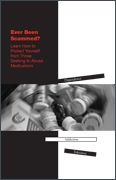Article
Advice on How to Spot a Doctor Shopper
This handy resource from the Pennsylvania Medical Society provides valuable guidance for clinicians and their staff on identifying patients who may abuse, misuse, or divert prescription opioids.

The brochure “Ever Been Scammed? Learn How to Protect Yourself from Those Seeking to Abuse Medications” was developed by the Pennsylvania Medical Society for physicians who are looking for information and resources “to help them differentiate patients with pain from those seeking to abuse or divert prescription medications.”
This 12-page brochure provides working definitions of “tolerance,” “dependence,” and “addiction;” discusses factors that may have contributed to the increase in opioid misuse and abuse; and identifies “red flags” that may be exhibited by individuals who are in search of prescription painkillers beyond what is therapeutically required.
Potential red flags that may indicate a patient is a doctor shopper include patients who:
- Present with a poorly defined or difficult to diagnose injury
- Deliver well-rehearsed stories of pain, stress, or insomnia
- Refuse non-addictive alternatives and insist on addictive alternatives
- Push for the maximum amount/largest quantity of an addictive drug
- Tell physician which drugs work best
- Routinely request early refills or replacement prescriptions
- Make frequent claims of lost or stolen medication
The brochure also identifies several valuable resources that can help physicians identify drug seekers, including the Current Opioid Misuse Measure (COMM), which is available for download at PainEdu.org; the Addiction Behaviors Checklist, which is “a 20-item questionnaire designed to track behaviors that are characteristic of opioid addiction in chronic pain populations” that is available at the Partners Against Pain website; and the Pain Assessment and Documentation Tool, which measures “the four A’s of pain treatment outcomes: analgesia, activities of daily living, adverse effects, and aberrant drug taking,” and is available at the HealthInsight website.
Physicians will also find guidance on documenting a pain assessment, the benefits of using their state’s prescription drug monitoring database (PDMD), referring patients for substance abuse counseling and treatment, and the proper disposal of opioid medications.





